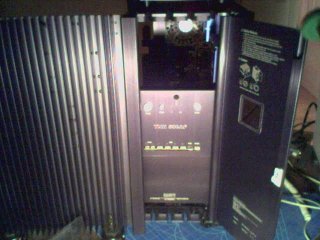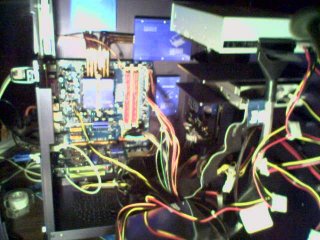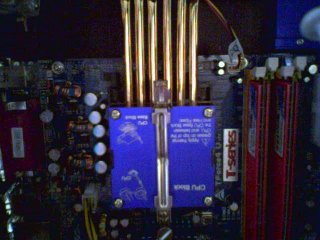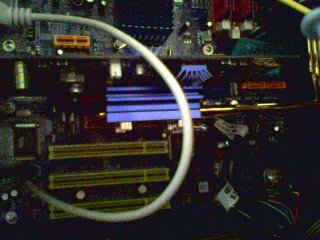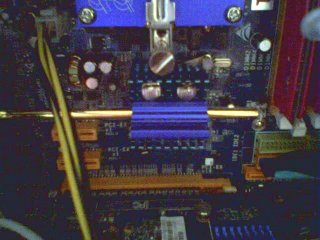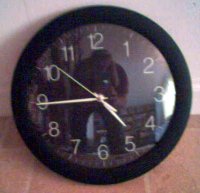|
Oh No! Zooty is dead! After many years of service it gave up the ghost once again at the end of August 2011. I'll probably bring back some older PC in zooty's case, but this time I decided to move on to more modern hardware that might not be totally silent, but hopefully I can keep the noise to a minimum. The evolving story of my new zooty starts here. Amazing Case
MotherboardMy most recent upgrade of zooty changed the motherboard to a Biostar TP43D2-A7 motherboard, an Intel Q9550S 4 core processor (a low power chip for better cooling) and 8 gig of memory. This new system is ideal for running KVM virtual machines, and in fact my Windows XP virtual machine seems faster than the real Windows XP box I have (but never turn on). Still using the Sapphire Radeon X700 Pro video adaptor from the original system. The previous incarnation of zooty was an AMD Athlon 64 X2 4400+ dual core cpu (the fastest dual core system I could get under the 100 watt limit for the CPU heatpipes), 2 gig of memory, and a Sapphire Radeon X700 Pro PCIe video adaptor (chosen mainly because it didn't have a very big fan on it, so I figured the heatpipes should work quite well). All this plugged into a BIOSTAR TForce4U socket 939 motherboard. The Biostar TForce4U was the 2nd motherboard I've had. The first was an ASUS A8N-E, but I became suspicious of the Asus after having some problems, and after some experience with the case, decided the Biostar was the best physical layout to accomodate all the heatpipes. It was the only 939 motherboard I could find with the northbridge chipset above the PCI slots and near the CPU so that the northbridge heatpipe could be used. It is too new to be on Zalman's compatibility list (which hasn't been updated for a while), but it seems to work perfectly. The biggest problem Biostar has is the insanely terse manual. Motherboard manuals are usually pretty light on the BIOS features, but the Biostar manual is light on everything (on the other hand, perhaps they are simply aware that no one reads the manuals anyway :-). The only way to find out what some of the stuff in the BIOS does is to experiment and look things up on google. One interesting feature I found was that the BIOS has memtest86 already built into it. If you enable the integrated memory test, it boots right into a copy of what sure looks like memtest86. Kind of handy to not need to find a CD with a boot image on it. Big ProblemsI probably should have been more suspicious from day one when I first put the system together and tried booting the Windows XP CD. Lots of folks on the net say they install XP with no problems on the ASUS A8N-E, yet every time I try, the Windows installer hangs forever almost the instant it starts (far faster than I can hit any keys to tell it I have drivers). I didn't want to run Windows anyway, and Fedora Core 5 installed flawlessly, so I ignored the Windows failure and used Fedora and all was well for a time. Then came the fateful day when I got home and the system was dead. Wouldn't boot, wouldn't POST, wouldn't even enter the BIOS. I eventually tried the memory one stick at a time, and found that one of the memory sticks was completely inert. I RMAed the memory, and finally got the system working again, only to have it mysteriously die again with completely different symptoms - now it acts like it is booting (judging from the lights and the floppy access after I power it up), but there is no video signal. I move the system where I can work on it better, take out the video card and try a cheap PCI card, but now it is acting differently again. It doesn't even look like it is trying to boot anymore. The only thing that happens when I try to power it up is the standby LED on the motherboard flashes at about 1HZ. I disconnect everything I can disconnect and try various things until I eventually get hold of a proper 24-pin ATX power supply and try that instead of the TNN500 PSU. The system works with the spare PSU, so it looks like I have another part to RMA. I try testing the memory again while I have the system working, and find that the stick of memory that was in the same slot that died last time has died again. I decide that something is cursed, so I'll get rid of as much stuff as possible in the hope that the curse will go with it. The motherboard, being one of the cheaper components, is on the list to go. Since I now have experience and know what too look for in the physical layout, the Biostar looked to be the best bet for this case. I also got new memory from a different manufacturer and am currently waiting on the new PSU (which is in transit). Little ProblemsAs expensive as this case is, you'd think they could afford to print a plus sign on the connectors from the case to the motherboard for power and disk activity LEDs, but no. As always, I plug them in backwards the first time, and have to flip them around before the lights work. Or if they can't print the +, at least mention which of the color wires from the rainbow colored ribbion cable is plus (or minus). It does take lots of space to work on this thing, you need room to swing the side of the case out and it is pretty heavy so moving it around to get someplace to work is a bit of a pain. The instructions tell you to use a "generous amount" of thermal paste when hooking up the pipes and blocks, but the one syringe of paste that comes with the case ran out about half way through the CPU install and I hadn't even gotten to the video card yet. Black anodized aluminum may look good, but it is really hard to see the black screw heads you need to get to down in between the black aluminum fins. I know the case doesn't need the sort of sealing that normal cases need to direct airflow, but it seems weird for the DVD and floppy to just be cantelevered out in open space. A miscue could easily drop a CD or a floppy inside the case, then you'd have to open it up to recover it. Some sort of mesh or screen cover that fits around the removable drives would make me feel better. Working with the case open means the DVD drive is swung around on the side that opens out so that the tray now opens into the interior of the case. This makes inserting media interesting :-). If you are running a dvd burning app that is gonna auto-eject when done, you don't want the front door to be closed when that happens (never done it yet, and my plan is to avoid ever doing it :-). The new TP43D2-A7 motherboard already had a passive cooled chipset on it, but with no fans in the case, it appears to be getting overheated when I do things like transfer big files to a usb hard drive. I'm seeing data corruption which goes away when I use rsync and the --bwlimit option to reduce the write speed to about half of what it could do at full speed. I've ordered a new passive chipset cooler with more fin surface, and once I get enough energy to take the whole system apart (I have to get to the back of the motehrboard), I'll replace it and see if things improve. TimelineFeb 17, 2006 - Friday: Order all the parts from newegg.com and quietpc.com. Feb 23, 2006 - Thursday: Everything except the case arrives. Feb 27, 2006 - Monday: The case arrives. I get the initial round of components installed and try powering up. My first reaction was "Oh no!, It doesn't work!", then I remembered - it isn't supposed to make any noise :-). Seems to work fine, the hardware monitor reports CPU temp of 34 C (it has a default warning temp of 72 C, so that seems reasonable - also only ran a few minutes). March 3, 2006 - Friday: Pretty much everything is working. Running a test version of Fedora Core 5 and plan to reinstall from scratch once the final release happens at the end of the month. All is well for a while... Jun 16, 2006 - Friday: First disaster. System not functional, track down the bad memory stick. Eventually get memory RMAed from corsair and system back to normal again. Jul 16, 2006 - Wednesday: Second disaster. Again system not functional, eventually track down power supply problem and memory dead again. Move disk drives to another computer so I can at least use the system (even if noisy :-). Aug 1, 2006 - Tuesday: Biostar motherboard arrives. Aug 9, 2006 - Wednesday: Rest of new parts arrive - memory, 120mm fan, and plenty of thermal paste :-). Get everything put together with new motherboard and use the spare power supply to check operation. So far things seem fine. Aug 16, 2006 - Wednesday: Replacement PSU arrives, only takes a few minutes to plug it back into the case, seems to be working, get the disks back in, stick it back on the shelf where it belongs, and it still works. Hopefully it will keep working for a long time now :-). Aug 29, 2009: Ordered the latest Intel chip and motherboard. Took everything apart and put new system together shortly after that. Final note: Out of curiosity (and because it was there), I tried to revive this system one last time to Jun 26, 2013. When I put the old original motherboard back, got all the heat pipe hooked up, then turned on the power, the power supply made a noise a lot like a string of firecrackers :-). Time for this case to make a trip to the old electronics recycling bin that happens to be located just down the street... |
